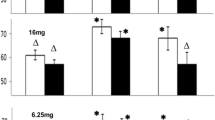Summary
The effects of E3810, a potent proton pump inhibitor, on gastric secretion and gastric or duodenal ulcers or erosions were studied in rats. Intraduodenal administration of E3810 dose dependently inhibited gastric secretion (volume and acid outputs) in pylorus-ligated rats. The effective dose required to inhibit volume output by 50% (ED50) was 12 mg/kg and that for acid output was 3.4 mg/kg. Acutely induced gastric ulcers or erosions, such as cold-restraint stress erosions, Shay ulcers and mercaptamine (cysteamine)-induced duodenal ulcers, were significantly inhibited by oral, intraduodenal or subcutaneous administration of E3810 at 1 to 100 mg/kg. The protective effects of E3810 in these acute models were compared with those of omeprazole at the same doses. At low doses, 10 mg/kg (intraduodenally) in Shay ulcers and 3 mg/kg (subcutaneously) in mercaptamine-induced ulcers, E3810 was significantly more effective than omeprazole. But at high doses, there was no significant difference between the 2 drugs in efficacy. In the cold stress erosion model, the drugs were equally effective.
Similar content being viewed by others
References
Bader J-P. Opening address. Scandinavian Journal of Gastroenterology 24 (Suppl. 166): 1–2, 1989
Figala V, Klemm K, Kohl B, Krüger U, Rainer G, et al. Acid activation of H++K+-ATPase inhibiting 2-(2-pyridyl-methyl-sulfinyl)-benzimidazoles: isolation and characterisation of the thiophilic ‘active principle’ and its reactions. Journal of the Chemical Society. Chemical Communications 125–127, 1986
Fujii Y, Ishii Y. Influence of various factors and drugs on cysteamine-induced duodenal ulcers in the rat. Japanese Journal of Pharmacology 25: 663–670, 1975
Fujisaki H, Shibata H, Oketani K, Murakami M, Fujimoto M, et al. Inhibitions of acid secretion by E3810 and omeprazole, and their reversal by glutathione. Biochemical Pharmacology 42: 321–328, 1991
Herling AW, Bickel M, Lang H-J, Weidmann K, Rösner M, et al. A substituted thieno[3,4-d]-imidazole versus substituted benimidazoles as H+ K+-ATPase inhibitors. Pharmacology 36: 289–297, 1988
Konturek SJ, Brzozowski T, Radecki T. Protective action of omeprazole, a benzimidazole derivative, on gastric mucosal damage by aspirin and ethanol in rats. Digestion 27: 159–164, 1983
Lindberg P, Nordberg P, Alminger T, Brändström A, Wallmark B. The mechanism of action of the gastric acid secretion inhibitor omeprazole. Journal of Medicinal Chemistry 29: 1327–1329, 1986
Long JF, Chiu JS, Derelanko MJ, Steinberg M. Gastric antisecretory and cytoprotective activities of SCH 28080. Journal of Pharmacology and Experimental Therapeutics 226: 114–120, 1983
Mattsson H, Andersson K, Larsson H. Omeprazole provides protection against experimentally induced gastric mucosal lesions. European Journal of Pharmacology 91: 111–114, 1983
Morii M, Takata H, Takeguchi N. Acid activation of omeprazole in isolated gastric vesicles, oxyntic cells, and gastric glands. Gastroenterology 96: 1453–1461, 1989
Morii M, Takata H, Fujisaki H, Takeguchi N. The potency of substituted benzimidazoles such as E3810, omeprazole, Ro 18-5364 to inhibit gastric H+, K+-ATPase is correlated with the rate of acid-activation of the inhibitor. Biochemical Pharmacology 39: 661–667, 1990a
Morii M, Takata H, Takeguchi N. Binding site of omeprazole in hog gastric H+, K+-ATPase. Biochemical and Biophysical Research Communications 167: 754–760, 1990b
Murakami M, Oketani K, Fujisaki H, Wakabayashi T, Ohgoh T, et al. Fundamental studies of the changes of gastric muco-substances induced by cold-restraint stress in rats. Journal of Kyoto Prefecture University Medicine 90: 443–451, 1981 (in Japanese)
Okabe S, Higaki E, Higuchi T, Sato M, Hara K. Biochemical and pharmacological analysis of 2-[(2dimethylaminobenzyl)sulfinyl] benzimidazole (NC-1300), a new proton pump inhibitor. Japanese Journal of Pharmacology 40: 239–249, 1986
Satoh H, Inatomi N, Nagaya H, Inada I, Nohara A, et al. Antisecretory and antiulcer activities of a novel proton pump inhibitor AG-1749 in dogs and rats. Journal of Pharmacology and Experimental Therapeutics 248: 806–815, 1989
Shay H, Komarov SA, Fols SS, Meranze D, Gruenstein M, et al. A simple method for the uniform production of gastric ulceration in rats. Gastroenterology 5: 43–61, 1945
Yamamoto O, Okada Y, Okabe S. Effects of a proton pump inhibitor, omeprazole, on gastric secretion and gastric and duodenal ulcers or erosions in rats. Digestive Diseases and Sciences 29: 394–401, 1984
Author information
Authors and Affiliations
Rights and permissions
About this article
Cite this article
Fujisaki, H., Shibata, H., Oketani, K. et al. Effects of the Proton Pump Inhibitor, E3810, on Gastric Secretion and Gastric and Duodenal Ulcers or Erosions in Rats. Drug Invest. 3, 328–332 (1991). https://doi.org/10.1007/BF03259747
Published:
Issue Date:
DOI: https://doi.org/10.1007/BF03259747




